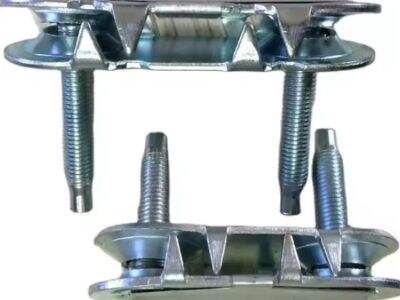Chevroni transpordibandid on paljudes tööstusharudes üks olulisemaid osasid. Taskukonveejärk Kasutaja on mõeldud materjalide tõstmiseks üles või alla kalda, et lihtsustada asjade üleviimist ühest kohast teise. Õige konveierrihmade valimine teie rakenduse jaoks: A kuni Z n Teie tööstuse vajadustele vastava täiusliku konveierrihmade valimine on oluline teie ettevõtte sujuva ja järjepideva toimimise tagamiseks.
Chevroni transpordiambade erinevused
Chevroni transpordiambad: omadused ja eelisedChevroni transpordiambad on mitmesugused, mis on nõuetekohaselt klassifitseeritud vastavalt vajadustele. Chevronid on kolmest põhilisest variandist: avatud V-vormis, suletud V-vormis ja U-vormis. Avada V Sõrmuga toimetamise jaam on kõige paremad järsu kalduvusel koorma kandmiseks, samas kui suletud V-chevron-rihmadega edastatakse materjali vähem kalduvusel, nii et mõlemal kasutusel on oma rakendusala. Lehe-tüüpi puurite puhul on U-kujulised chevron-rihmad projekteeritud koos lameda ja kokku pandud V-ruugiga lõigetega.
Pluspunktid: enne Chevroni transpordipaela ostmist
Kui otsid oma tööstuse jaoks suurepärase rööbaskonveierlindi, siis on mõned tegurid, millel pead tähelepanu pöörama. Need hõlmavad materjalilisi omadusi, tõusenurka, lindi kiirust ja keskkonda, kus linta kasutatakse. Soovid valida rööbaskonveierlindi, mis sobib su tööstusega, on vastupidav ja töötab usaldusväärselt.
Valige sobiv rööbaslindi profiil oma kasutusjuhu jaoks
Teie rakenduse jaoks soovitatud rööbriprofiil sõltub veetavate materjalide tüübist ja nende tõusust. Sügav rööbriprofiil — kui materjalid on libiseda või nihkuda kaldu, võib nende haaramiseks vajuda sügavamat rööbriprofili. Vastupidiselt võivad stabiilsemad materjalid nõuda ainult pinda rööbriprofili. Pea meeles, et nendega täpse disaini, mida me õpetame teile meie juhendatud paigaldustutoriaalide kaudu, on oluline hoolikalt hinnata, mis on teie vajadused ja koostööd teha professionaaliga, et selgitada välja, milline rööbriprofiil sobib kõige paremini teie rakenduste eritingimustele.
Kuidas materjalid võrdlevad rööbri transportööribändi eluea ja toimivusega?
Iga materjal pakub erinevat kestvuse ja toimivuse taseme. Rööbri kummist vedrud: Need KAASLAUD on vastupidavad ja mitmekülgsed, mis sobivad raskete tööde jaoks. Kõige sagedamini kasutatakse tekstiil-ševronrihmade kergete ja keskmise töövõimsusega rakenduste jaoks, mis nõuavad umbes 120 kraadi C temperatuuri, kuna tööstusharudel on erinevad nõuded. Keemiliste ja õlivastased PVC-chevron-rihmad on ideaalsed tööstustele, kus on sellised karmid tingimused.
Kuidas paigaldada ja hooldada oma Chevron-konveerivöö?
Chevron-konveeriva vöö peab olema hoolikalt paigaldatud, ohutu kasutamine ja igapäevane hooldus, et pikendada chevroni konveeriva vöö eluiga. Kui seadmed paigaldatakse vastavalt tootja soovile, ei pruugi töös probleeme tekkida. Korraldus katki Transpordiringid samuti tuleb koheselt parandada probleeme, et probleem ei võtaks osa tööajast, mis toob kaasa kallid ümberkorraldused.
Et saada maksimaalset kasu oma chevron-konveerijälgest, peate tagama selle nõuetekohase paigaldamise ja kasutamise kokkuvõttes, et teada saada, milline on teie tööstuse ja rakenduse jaoks parim valik, sõltub tegelikult materjali tüübist, nõutavast kalduvusastmest ja keskkonnateguritest. Teades, milliseid erinevaid konveierriie on, kindlaksmäärades õige konveierriide mudelit, võrdledes materjalide kestvust ja toimivust ning järgides paigaldamise ja hooldamise tavasid, saate oma äri tõhususe maksimeerida.


 EN
EN
 AR
AR
 BG
BG
 HR
HR
 CS
CS
 NL
NL
 FR
FR
 DE
DE
 HI
HI
 IT
IT
 JA
JA
 KO
KO
 PT
PT
 RO
RO
 RU
RU
 ES
ES
 SV
SV
 TL
TL
 ID
ID
 LT
LT
 SR
SR
 SK
SK
 SL
SL
 UK
UK
 VI
VI
 SQ
SQ
 ET
ET
 GL
GL
 HU
HU
 TR
TR
 AF
AF
 GA
GA
 BE
BE
 MK
MK
 MN
MN
 NE
NE
 KK
KK
 UZ
UZ
 KY
KY
 XH
XH

